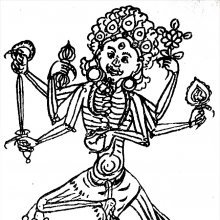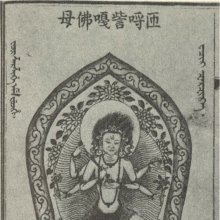Vajracarcika, Vajracarcikā: 2 definitions
Introduction:
Vajracarcika means something in Buddhism, Pali, Hinduism, Sanskrit. If you want to know the exact meaning, history, etymology or English translation of this term then check out the descriptions on this page. Add your comment or reference to a book if you want to contribute to this summary article.
Alternative spellings of this word include Vajracharchika.
Images (photo gallery)
In Buddhism
Tibetan Buddhism (Vajrayana or tantric Buddhism)
Source: archive.org: The Indian Buddhist IconographyVajracarcikā (वज्रचर्चिका) refers to one of the female emanations of Akṣobhya, as mentioned in the 5th-century Sādhanamālā (a collection of sādhana texts that contain detailed instructions for rituals).—Her Colour is red; her Āsana is dancing in ardhaparyaṅka; her Distinctive feature is emaciated body; her Vāhana is a corpse; her Appearance is terrible; she has six arms.—Only one sādhana in the Sādhanamālā describes the form of Vajracarcikā.
The Dhyāna (meditation instructions) of Vajracarcikā described in the Sādhanamālā as follows:—
“The worshipper should conceive himself as Vajracarcikā, who is three-eyed and one-faced, dances in the ardhaparyaṅka attitude on a corpse, is emaciated in appearance and looks terrible with bare fangs. Her neck is embellished by a garland of human heads, and she is decked in ornaments of bones, is endowed with the five auspicious symbols, bears the image of Akṣobhya on the crown, is clad in garments of tiger-skin and has dishevelled hair. She is six-armed and carries in her three right hands the vajra, the sword, and the cakra and in her three left the kapāla, the jewel and the lotus. She is red in colour but changes to white and other colours in accordance with the different purposes for which she is invoked. Thus meditating...”

Tibetan Buddhism includes schools such as Nyingma, Kadampa, Kagyu and Gelug. Their primary canon of literature is divided in two broad categories: The Kangyur, which consists of Buddha’s words, and the Tengyur, which includes commentaries from various sources. Esotericism and tantra techniques (vajrayāna) are collected indepently.
Languages of India and abroad
Sanskrit dictionary
Source: Cologne Digital Sanskrit Dictionaries: Edgerton Buddhist Hybrid Sanskrit DictionaryVajracarcikā (वज्रचर्चिका).—name of a goddess: Sādhanamālā 395.13.
Sanskrit, also spelled संस्कृतम् (saṃskṛtam), is an ancient language of India commonly seen as the grandmother of the Indo-European language family (even English!). Closely allied with Prakrit and Pali, Sanskrit is more exhaustive in both grammar and terms and has the most extensive collection of literature in the world, greatly surpassing its sister-languages Greek and Latin.
See also (Relevant definitions)
Relevant text
Search found 1 books and stories containing Vajracarcika, Vajracarcikā; (plurals include: Vajracarcikas, Vajracarcikās). You can also click to the full overview containing English textual excerpts. Below are direct links for the most relevant articles:
The Indian Buddhist Iconography (by Benoytosh Bhattachacharyya)
Related products

